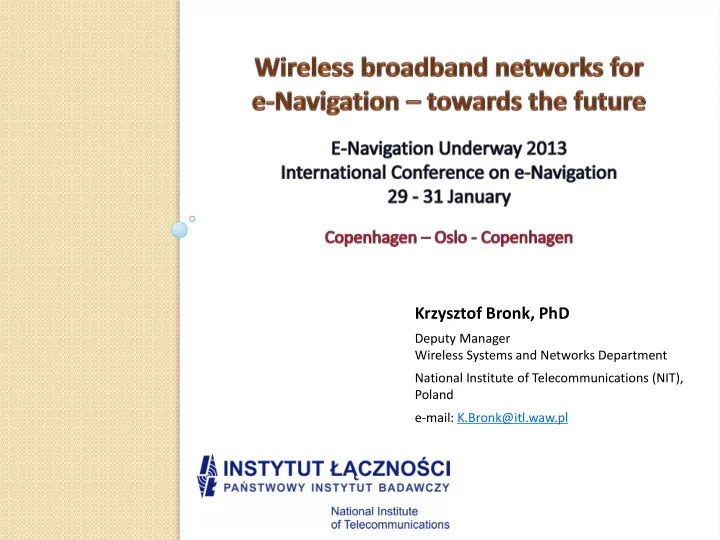

PAGE 1 Krzysztof Bronk, PhD Deputy Manager Wireless Systems and Networks Department National Institute of Telecommunications (NIT), Poland e-mail: K.Bronk@itl.waw.pl
Presentation outline PAGE 2 Introduction Currently existing and utilised wireless technologies EfficienSea measurement campaign conclusions NetBaltic – R&D project Main concept Proposed architecture Potential benefits - Summary 30 January 2013 e-Navigation Underway 2013
Introduction 30 January 2013 e-Navigation Underway 2013
Wireless technology Merits Flaws Quite good ranges Throughput often too small GSM Existing and very good infrastructure Costs may be substantial Fair latency Fair ranges Existing and good infrastructure Costs may be substantial UMTS/HSPA Small latency High load reduces quality and range High throughput Small ranges Very small latency LTE Costs may be substantial Very high throughput Very poor infrastructure Very good ranges Costs may be substantial CDMA 450 Fair latency Quite poor infrastructure Fair throughput Very high throughput Very small latency Very small ranges WiFi Existing and good infrastructure Available only near ports and cities Often for free High throughput Costs may be substantial WiMAX Small latency Poor infrastructure Fair ranges Long range reduces throughput Often very high costs Almost global coverage Satellite systems Huge latency Existing and good infrastructure Throughput often too small Costs may be substantial Great ranges Very small throughput VHF data solutions Maritime dedicated solution Substantial latency 30 January 2013 e-Navigation Underway 2013 Very poor infrastructure
EfficienSea measurement campaign Over 1500 miles and 41127 measurement locations !!! Along Polish coast, bay of Gdansk, Øresund strait, along south-west Swedish coast to Bornholm Multiple data system GSM, EDGE, UMTS, HSPA, Iridium, Telenor VHF Data 30 January 2013 e-Navigation Underway 2013
EfficienSea measurement campaign PAGE 6 Measured parameters • Signal strength • Basic data transmission services availability • Average throughput in downlink and uplink • Average transmission delays • Position, speed, course and timestamp • Serving network and base station identification parameters 30 January 2013 e-Navigation Underway 2013
PAGE 7
EfficienSea measurement campaign conclusions The cellular networks are almost always available in the Gulf of Gdansk and in the Øresund strait. The throughput exceeds (50% cases) 250 kbps in the uplink and 500 kbps in the downlink. In many cases the speed of data reached 3 Mbps especially in the Danish Straits. For the antenna height of 3 m AMSL availability of the cellular networks 2G/3G services does not exceed 12 NM. For the antenna height of 10 m AMSL the communication ranges reached 35 km with a data speed up to 800 kbps. If minimum data transmission delays are the priority, the 3G networks appear to be the most attractive solution. Increasing the receiving antenna height improves the range as well as the throughput. VHF Data system provides better ranges (up to 50 km from the base station) but with the maximum data speed of 22,5 kbps. In the cellular networks the ranges are up to 35 km, transmission speeds are higher and the land infrastructure is definitely better. The Iridium system provides nominal transmission speeds (it depends on the satellite constellation visible from the particular spot) with much bigger delays than terrestrial systems, but its main advantage is that it is operational globally. 30 January 2013 e-Navigation Underway 2013
NetBaltic – Main concept “ NetBaltic – self-organizing multisystem broadband network for the purposes of the e-Navigation, Baltic monitoring and internet services availability enhancement” • Definition of the infrastructure elements ( based on existing wireless technologies ) for the new self- organising wireless broadband network for data exchange between ships, between ships and data storage/processing centers and between ships and the Internet network • Novel procedures for the wireless access-network, based on the self-organizing mesh network structure, and the multi-hop transmission algorithms • Test-bed in the Bay of Gdansk 30 January 2013 e-Navigation Underway 2013
NetBaltic – System architecture 30 January 2013 e-Navigation Underway 2013
NetBaltic – System architecture • The A-zone covers water areas having a direct connection with a shore-based infrastructure • The communication in this zone is organized in a typical manner • The radio-link is considered to be a wireless access link • Depending on the propagation conditions, the zone’s range will change • Terminals within the zone will have unlimited Internet access • The most appropriate wireless technology will be selected • User demands (service), costs, technical capabilities and hydro-meteorological conditions 30 January 2013 e-Navigation Underway 2013
NetBaltic – System architecture • The B-zone expands the A- Zone’s range through the self- organising mesh-network • The terminals with the direct connection to the shore base stations (within the A-zone) can share their links with the terminals that are currently outside the A-zone • Indirect transmission and dynamically changing network topology • The C-zone is where the vessel has no network access (it is outside A- and B-zones) • The store-and-forward transmission is anticipated to be used • The vessel can redirect some data packets to ships which are likely to reach A- or B-zones earlier than the vessel itself • Possible AIS utilization 30 January 2013 e-Navigation Underway 2013
Potential benefits - Summary • The system efficiency verification • In its destined area of operation • To prove its superiority in comparison with existing solutions • Potential benefits • Service-oriented wireless technology selection • E-Navigation dedicated solution • Quality and availability enhancement • Higher throughput • Smaller dalays • Greater ranges • Lower operating costs 30 January 2013 e-Navigation Underway 2013
PAGE 14 Thank you for your attention! Contact: Krzysztof Bronk Wireless Systems and Networks Department National Institute of Telecommunications (NIT) Jaskowa Dolina Str. 15 80-252 Gdansk Poland e-mail: K.Bronk@itl.waw.pl fax: +48583417112 mob: +48790019315 30 January 2013 e-Navigation Underway 2013
Recommend
More recommend